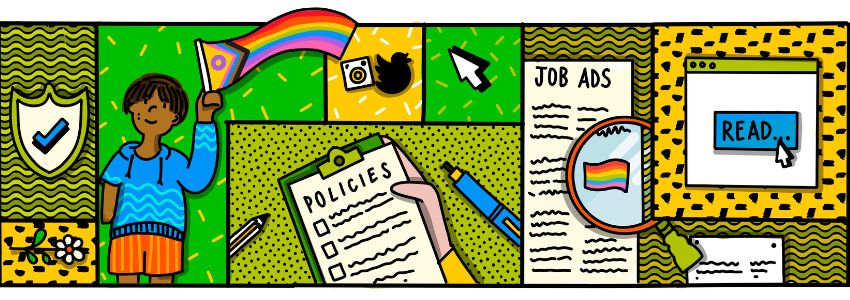If you’re after a more accessible way to read this article, check out the Easy Read version!
For many LGBTQ+ people, it’s important to know if an employer is LGBTQ-inclusive. But how do you find out this information?
Use the following when you’re looking for jobs.
You can also explore the best employers for LGBTQ+ people here: Stonewall Top 100 Employers.

Top tips for finding an LGBTQ-inclusive employer
1. Check the application
Does the employer mention diverse applicants in the application form or application pack? Do they clearly welcome LGBTQ+ applicants, or make a clear statement that they don't discriminate based on gender identity or sexual orientation?
2. Find out about their staff network groups
Lots of organisations have staff network groups for different identities and protected characteristics. An LGBTQ+ staff network group is a way to connect with LGBTQ+ colleagues and get support. If you can't find information on staff network groups on an employer's website, get in touch to ask if they have them.
3. Search their website
If you put 'equality', ‘equity’, or ‘diversity’ into the website search bar, what comes up? Lots of organisations have public statements on equality, diversity and inclusion. Check if the organisation specifically talks about LGBTQ+ communities on their equality, diversity, inclusion, or equity webpage.
4. Look for Stonewall logos
We work with over 900 organisations to improve LGBTQ+ inclusion. Most of them proudly display the ‘Stonewall Diversity Champion’ or ‘Global Diversity Champion’ logo on their job pages or application forms. A Stonewall ‘Top 100 Employers’ logo, or a Stonewall Gold, Silver or Bronze Employer logo means an organisation has also worked hard on LGBTQ-inclusion.
5. Where are their jobs listed?
Stonewall's Proud Employers website lists vacancies with our Diversity Champions. By choosing to advertise roles on Proud Employers, organisations show a real commitment to recruiting diverse talent and advancing LGBTQ+ equality.
6. Ask about their policies and benefits
Does an employer state that parental leave, adoption leave, and compassionate leave are available to all staff, regardless of sexual orientation or gender identity? Does it use gender-inclusive language in policies such as ‘partner’ or ‘birth-parent’, and is there a gender-neutral dress code? Does it have a trans inclusion policy? Are compassionate leave policies inclusive of loved ones, chosen families and close support networks, and do special leave policies include time to support someone through transition? Ask your prospective employer about the policies that matter most to you.
7. Do they have senior LGBTQ+ champions?
Some of the most inclusive organisations have someone at the top who champions equality, diversity and inclusion. These senior members of staff visibly advocate for LGBTQ+ equality in the workplace. Can you see these staff on the organisation’s website?
8. Do they know about their demographics?
Can your future employer tell you how many women, disabled people or LGBTQ+ people work there? If they can, it's because they've taken the time to ask their staff – a good indicator of inclusive practice. The best organisations use this information to ensure there are no barriers for any employees.
9. Would you use their services?
Whether it's a healthcare provider, a bank or a retailer, is the organisation doing anything special to authentically attract LGBTQ+ customers and service users and ensure they provide services which are inclusive of everyone?
10. Check their social media presence
Lots of organisations are proud to show what they're doing to celebrate events like Pride, Black History Month or Trans Day of Visibility. Have a look at an organisation's Twitter, Instagram and LinkedIn pages to see what they do to celebrate diversity.


 Send
Send Share
Share Email
Email